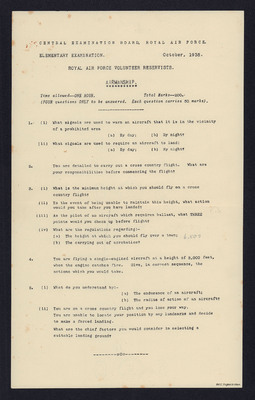Airmanship exam
Title
Airmanship exam
Description
Royal Air Force volunteer reserve, elementary exam in airmanship with five questions.
Date
1938-10
Temporal Coverage
Coverage
Language
Type
Format
One page typewritten document
Publisher
Rights
This content is available under a CC BY-NC 4.0 International license (Creative Commons Attribution-NonCommercial 4.0). It has been published ‘as is’ and may contain inaccuracies or culturally inappropriate references that do not necessarily reflect the official policy or position of the University of Lincoln or the International Bomber Command Centre. For more information, visit https://creativecommons.org/licenses/by-nc/4.0/ and https://ibccdigitalarchive.lincoln.ac.uk/omeka/legal.
Contributor
Identifier
MRosserLV745193-190517-44
Transcription
CENTRAL EXAMINATION BOARD, ROYAL AIR FORCE.
ELEMENTARY EXAMINATION. October, 1938.
ROYAL AIR FORCE VOLUNTEER RESERVISTS.
[underlined] AIRMANSHIP. [/underlined]
Time allowed – ONE HOUR. Total Marks – 200.
(FOUR questions ONLY to be answered. Each question carries 50 marks).
1. (i) What signals are used to warn an aircraft that it is in the vicinity of a prohibited area
(a) By day; [b] By night?
(ii) What signals are used to require an aircraft to land:
(a) By day; (b) By night?
2. You are detailed to carry out a cross country flight. What are your responsibilities before commencing the flight?
3. (i) What is the minimum height at which you should fly on a cross country flight?
(ii) In the event of being unable to maintain this height, what action would you take after you have landed?
(iii) As the pilot of an aircraft which requires ballast, what THREE points would you check up before flight?
(iv) What are the regulations regarding:-
(a) The height at which you should fly over a town; [inserted] 6,000 [/inserted]
(b) The carrying out of acrobatics?
4. You are flying a single-engined aircraft at a height of 3,000 feet, when the engine catches fire. Give, in correct sequence, the actions which you would take.
5. (i) What do you understand by:-
(a) The endurance of an aircraft;
(b) The radius of action of an aircraft?
(ii) You are on a cross country flight and you lose your way.
You are unable to locate your position by any landmarks and decide to make a forced landing.
What are the chief factors you would consider in selecting a suitable landing ground?
ELEMENTARY EXAMINATION. October, 1938.
ROYAL AIR FORCE VOLUNTEER RESERVISTS.
[underlined] AIRMANSHIP. [/underlined]
Time allowed – ONE HOUR. Total Marks – 200.
(FOUR questions ONLY to be answered. Each question carries 50 marks).
1. (i) What signals are used to warn an aircraft that it is in the vicinity of a prohibited area
(a) By day; [b] By night?
(ii) What signals are used to require an aircraft to land:
(a) By day; (b) By night?
2. You are detailed to carry out a cross country flight. What are your responsibilities before commencing the flight?
3. (i) What is the minimum height at which you should fly on a cross country flight?
(ii) In the event of being unable to maintain this height, what action would you take after you have landed?
(iii) As the pilot of an aircraft which requires ballast, what THREE points would you check up before flight?
(iv) What are the regulations regarding:-
(a) The height at which you should fly over a town; [inserted] 6,000 [/inserted]
(b) The carrying out of acrobatics?
4. You are flying a single-engined aircraft at a height of 3,000 feet, when the engine catches fire. Give, in correct sequence, the actions which you would take.
5. (i) What do you understand by:-
(a) The endurance of an aircraft;
(b) The radius of action of an aircraft?
(ii) You are on a cross country flight and you lose your way.
You are unable to locate your position by any landmarks and decide to make a forced landing.
What are the chief factors you would consider in selecting a suitable landing ground?
Collection
Citation
“Airmanship exam,” IBCC Digital Archive, accessed July 27, 2024, https://ibccdigitalarchive.lincoln.ac.uk/omeka/collections/document/36721.
Item Relations
This item has no relations.

